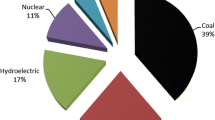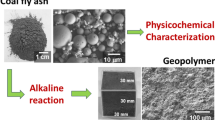Abstract
The production of fly ash as a solid waste of coal combustion increases with electricity demand growth in Indonesia. Fly ash is usually discarded in landfills due to its lack of utilization. Poor handling of the material can cause pollution and harm to human health. One potential of fly ash that can be further explored is as an alternative source of rare earth elements. The use of citric acid in the recovery process will be more environmentally friendly. The magnetic phase of fly ash is used as it is more favorable for the leaching process due to the smaller amount of acid-resistant components. This research aims to study the leaching mechanisms, evaluate the effect of temperature and acid concentration, and determine the appropriate kinetics model. Magnetic fly ash of less than 38 µm was leached using 300 mL of citric acid with an S/L ratio of 1:10 at a 400 rpm stirring rate. The leaching experiments were carried out for 4 h and samples were taken at the designated time. Acid concentration of 0.5 M, 1 M, 1.5 M, and 2 M was used, while the temperature was varied from 25 ºC, 45 ºC, 65 ºC, and 75 ºC to 90 ºC. The results show that acid concentration does not affect La, Ce, and Y recovery. Meanwhile, the temperature has a significant impact where the recovery increases as temperature elevates. Leaching at lower temperatures (25 ºC and 45 ºC) fits the Z–L–T kinetics model, while at higher temperatures (65 ºC, 75 ºC, and 90 ºC) it follows the Kröger-Ziegler model.
Graphical Abstract








Similar content being viewed by others
References
Suharyanti I, Pambudi SH, Wibowo JL, Pratiwi NI (2019) Indonesia energy outlook 2019. Secretariat General of the National Energy Council, Jakarta Selatan
Arinaldo D, Adiatma JC (2019) Indonesia’s coal dynamics: toward a just energy transition. Institute for Essential Services Reform (IESR), Jakarta Selatan
Franus W, Wiatros-Motyka MM, Wdowin M (2015) Coal fly ash as a resource for rare earth elements. Environ Sci Pollut Res 22:9464–9474. https://doi.org/10.1007/s11356-015-4111-9
Damayanti R (2018) Coal ash and its utilization: a technical review on its chemically characteristics and toxicology. J Teknol Miner dan Batubara 14:213–231. https://doi.org/10.30556/jtmb.vol14.no3.2018.966
Yao ZT, Ji XS, Sarker PK et al (2015) A comprehensive review on the applications of coal fly ash. Earth-Sci Rev 141:105–121. https://doi.org/10.1016/j.earscirev.2014.11.016
He Y, Luo Q, Hu H (2012) Situation analysis and countermeasures of China’s fly ash pollution prevention and control. Procedia Environ Sci 16:690–696. https://doi.org/10.1016/j.proenv.2012.10.095
Bac BH, Nam BX, Hieu VD, Dung NT (2012) Characterization of a Vietnamese coal fly ash and its possible utilizations. In: Nam BX (ed) Advances in mining and tunneling. Publishing House for Science and Technology, Hanoi, pp 434–438
Suarez-Ruiz I, Valentim B, Borrego AG et al (2017) Development of a petrographic classification of fly-ash components from coal combustion and co-combustion. (An ICCP classification system, fly- ash working group—commission III.). Int J Coal Geol 183:188–203. https://doi.org/10.1016/j.coal.2017.06.004
Dai S, Zhao L, Peng S et al (2010) Abundances and distribution of minerals and elements in high-alumina coal fly ash from the Jungar Power Plant, Inner Mongolia, China. Int J Coal Geol 81:320–332. https://doi.org/10.1016/j.coal.2009.03.005
Taggart RK, Hower JC, Dwyer GS, Hsu-Kim H (2016) Trends in the rare earth element content of U.S.-based coal combustion fly ashes. Environ Sci Technol 50:5919–5926. https://doi.org/10.1021/acs.est.6b00085
Seredin VV, Dai S (2012) Coal deposits as potential alternative sources for lanthanides and yttrium. Int J Coal Geol 94:67–93. https://doi.org/10.1016/j.coal.2011.11.001
Dutta T, Kim K-H, Uchimiya M et al (2016) Global demand for rare earth resources and strategies for green mining. Environ Res 150:182–190. https://doi.org/10.1016/j.envres.2016.05.052
Ge J, Lei Y, Zhao L (2016) China’s rare earths supply forecast in 2025: A dynamic computable general equilibrium analysis. Minerals 6:1–16. https://doi.org/10.3390/min6030095
Mancheri NA (2015) World trade in rare earths, Chinese export restrictions, and implications. Resour Policy 46:262–271. https://doi.org/10.1016/j.resourpol.2015.10.009
Simoni M, Kuhn EP, Morf LS et al (2015) Urban mining as a contribution to the resource strategy of the Canton of Zurich. Waste Manage 45:10–21. https://doi.org/10.1016/j.wasman.2015.06.045
Alonso E, Sherman AM, Wallington TJ et al (2012) Evaluating rare earth element availability: a case with revolutionary demand from clean technologies. Environ Sci Technol 46:3406–3414. https://doi.org/10.1021/es203518d
Nguyen RT, Imholte DD (2016) China’s rare earth supply chain: illegal production, and response to new cerium demand. JOM 68:1948–1956. https://doi.org/10.1007/s11837-016-1894-1
Zhou B, Li Z, Chen C (2017) Global potential of rare earth resources and rare earth demand from clean technologies. Minerals 7:1–14. https://doi.org/10.3390/min7110203
Zhang K, Kleit AN, Nieto A (2017) An economics strategy for criticality—application to rare earth element Yttrium in new lighting technology and its sustainable availability. Renew Sustain Energy Rev 77:899–915. https://doi.org/10.1016/j.rser.2016.12.127
Walawalkar M, Nichol CK, Azimi G (2016) Process investigation of the acid leaching of rare earth elements from phosphogypsum using HCl, HNO3, and H2SO4. Hydrometallurgy 166:195–204. https://doi.org/10.1016/j.hydromet.2016.06.008
Panda R, Kumari A, Jha MK et al (2014) Leaching of rare earth metals (REMs) from Korean monazite concentrate. J Ind Eng Chem 20:2035–2042. https://doi.org/10.1016/j.jiec.2013.09.028
Roth E, Macala M, Lin R, et al (2017) Distributions and extraction of rare earth elements from coal and coal by-products. In: World Coal Ash. http://www.flyash.info/2017/113-Roth-woca2017p.pdf. Accessed 3 Feb 2019
Kashiwakura S, Kumagai Y, Kubo H, Wagatsuma K (2013) Dissolution of rare earth elements from coal fly ash particles in a dilute H2SO4 solvent. Open J Phys Chem 3:69–75. https://doi.org/10.4236/ojpc.2013.32009
Peterson R, Heinrichs M, Glier J, et al (2017) Recovery of rare earth elements from coal ash with a recycling acid leach process. In: World Coal Ash. http://www.flyash.info/2017/128-Peterson-woca2017p.pdf. Accessed 3 Feb 2019
Voicu G, Ciobanu C, Istrate IA, Tudor P (2020) Emissions control of hydrochloric and fluorhydric acid in cement factories from Romania. Int J Environ Res Public Health 17:1–13. https://doi.org/10.3390/ijerph17031019
Roy P, Sardar A (2015) SO2 emission control and finding a way out to produce sulphuric acid from industrial SO2 emission. J Chem Eng Process Technol 6:1–7. https://doi.org/10.4172/2157-7048.1000230
Wang L, Wang J, Tan X, Fang C (2020) Analysis of NOx pollution characteristics in the atmospheric environment in Changchun city. Atmosphere (Basel) 11:1–12. https://doi.org/10.3390/ATMOS11010030
Manurung H, Rosita W, Bendiyasa IM et al (2020) Recovery of rare earth elements and yitrium from non-magnetic coal fly ash using acetic acid solution. Met Indones 42:35–42
Prihutami P, Sediawan WB, Astuti W, Prasetya A (2020) Effect of temperature on rare earth elements recovery from coal fly ash using citric acid. IOP Conf Ser Mater Sci Eng 742:1–7. https://doi.org/10.1088/1757-899X/742/1/012040
Ciriminna R, Meneguzzo F, Delisi R, Pagliaro M (2017) Citric acid: emerging applications of key biotechnology industrial product. Chem Cent J 11:1–9. https://doi.org/10.1186/s13065-017-0251-y
Huang K, Inoue K, Harada H et al (2011) Leaching of heavy metals by citric acid from fly ash generated in municipal waste incineration plants. J Mater Cycles Waste Manage 13:118–126. https://doi.org/10.1007/s10163-011-0001-5
Yuliusman ARA, Wulandari PT et al (2018) Selection of organic acid leaching reagent for recovery of zinc and manganese from zinc-carbon and alkaline spent batteries. IOP Conf Ser Mater Sci Eng 333:1–6. https://doi.org/10.1088/1757-899X/333/1/012041
Astuti W, Hirajima T, Sasaki K, Okibe N (2016) Comparison of atmospheric citric acid leaching kinetics of nickel from different Indonesian saprolitic ores. Hydrometallurgy 161:138–151. https://doi.org/10.1016/j.hydromet.2015.12.015
Kirimura K, Honda Y, Hattori T (2011) Citric acid. In: Moo-Young M (ed) Comprehensive biotechnology, 2nd edn. Elsevier B.V, Amsterdam, pp 135–142
Crundwell FK (2017) On the mechanism of the dissolution of quartz and silica in aqueous solutions. ACS Omega 2:1116–1127. https://doi.org/10.1021/acsomega.7b00019
Rosita W, Bendiyasa IM, Perdana I, Anggara F (2020) Recovery of rare earth elements and Yttrium from Indonesia coal fly ash using sulphuric acid leaching. AIP Conf Proc 2223:1–6. https://doi.org/10.1063/5.0000836
Bojinova D, Teodosieva R (2016) Extraction of elements from coal fly ash using thermo-hydrometallurgical method. J Chem Technol Metall 51:577–587
Lin S, Li K, Yang Y et al (2020) Microwave-assisted method investigation for the selective and enhanced leaching of manganese from low-grade pyrolusite using pyrite as the reducing agent. Chem Eng Process: Process Intensif. https://doi.org/10.1016/j.cep.2020.108209
Lin S, Gao L, Yang Y et al (2020) Efficiency and sustainable leaching process of manganese from pyrolusite-pyrite mixture in sulfuric acid systems enhanced by microwave heating. Hydrometallurgy 198:1–12. https://doi.org/10.1016/j.hydromet.2020.105519
Kukier U, Ishak CF, Sumner ME, Miller WP (2003) Composition and element solubility of magnetic and non-magnetic fly ash fractions. Environ Pollut 123:255–266. https://doi.org/10.1016/S0269-7491(02)00376-7
Rowe MC, Brewer BJ (2018) AMORPH: a statistical program for characterizing amorphous materials by X-ray diffraction. Comput Geosci 120:21–31. https://doi.org/10.1016/j.cageo.2018.07.004
Aughenbaugh KL, Stutzman P, Juenger MCG (2016) Identifying glass compositions in fly ash. Front Mater 3:1–10. https://doi.org/10.3389/fmats.2016.00001
Rosita W, Bendiyasa IM, Perdana I, Anggara F (2020) Sequential particle-size and magnetic separation for enrichment of rare-earth elements and yttrium in Indonesia coal fly ash. J Environ Chem Eng 8:1–10. https://doi.org/10.1016/j.jece.2019.103575
Handoyo H (2019) Pelindian Logam Tanah Jarang dalam Magnetik Coal Fly Ash Menggunakan Asam Asetat Sebagai Pelindi (Rare earth elements leaching from magnetic coal fly ash using acetic acid as a leachant). Unversitas Gadjah Mada, Yogyakarta
Li L, Ge J, Wu F et al (2010) Recovery of cobalt and lithium from spent lithium ion batteries using organic citric acid as leachant. J Hazard Mater 176:288–293. https://doi.org/10.1016/j.jhazmat.2009.11.026
McDonald RG, Whittington BI (2008) Atmospheric acid leaching of nickel laterites review. Part II. Chloride and bio-technologies. Hydrometallurgy 91:56–69. https://doi.org/10.1016/j.hydromet.2007.11.010
Brown MA, Kropf AJ, Paulenova A, Gelis AV (2014) Aqueous complexation of citrate with neodymium(III) and americium(III): a study by potentiometry, absorption spectrophotometry, microcalorimetry, and XAFS. Dalton Trans 43:6446–6454. https://doi.org/10.1039/c4dt00343h
Li K, Jiang Q, Chen G et al (2021) Kinetics characteristics and microwave reduction behavior of walnut shell-pyrolusite blends. Bioresour Technol 319:1–11. https://doi.org/10.1016/j.biortech.2020.124172
Cao Y, Harjanto S, Shibayama A et al (2006) Kinetic study on the leaching of Pt, Pd and Rh from automotive catalyst residue by using chloride solutions. Mater Trans 47:2015–2024. https://doi.org/10.2320/matertrans.47.2015
Kayal PB (1976) Reaction of alkalimetal nitrates RbNo3 CsNo3 with silica and aluminosilicates. University of Calcutta, Kolkata
Hulbert SF, Popowich MJ (1969) Kinetics of reactions in ionic systems. Springer, Boston, MA
Dickinson CF, Heal GR (1999) Solid–liquid diffusion controlled rate equations. Thermochim Acta 340–341:89–103. https://doi.org/10.1016/S0040-6031(99)00256-7
Stevenson PC, Nervik WE (1961) The radiochemistry of the rare earths: scandium, yttrium, and actinium. National Academy of Sciences—National Research Council, Oak Ridge
Shannon RD (1976) Revised effective ionic radii and systematic studies of interatomic distances in halides and chaleogenides. Acta Crystallogr A 32:751–767
Wang Z, Dai S, Zou J et al (2019) Rare earth elements and yttrium in coal ash from the Luzhou power plant in Sichuan, Southwest China: concentration, characterization and optimized extraction. Int J Coal Geol 203:1–14. https://doi.org/10.1016/j.coal.2019.01.001
Acknowledgements
This study was facilitated by the Sustainable Mineral Processing Research Group and the Laboratory of Energy Conservation and Pollution Prevention, Department of Chemical Engineering, Universitas Gadjah Mada. The authors would like to thank Tanjung Awar-awar coal power plant, Tuban Regency, for providing the sample and the Research Unit for Mineral Technology, Indonesian Institute of Sciences, and for helping with the sample analysis.
Author information
Authors and Affiliations
Corresponding author
Ethics declarations
Conflict of interest
The authors confirm that there are no conflicts of interest associated with this publication and there has been no significant financial support for this work that could have influenced its outcome.
Additional information
The contributing editor for this article was Grace Ofori-Sarpong.
Publisher's Note
Springer Nature remains neutral with regard to jurisdictional claims in published maps and institutional affiliations.
Rights and permissions
About this article
Cite this article
Prihutami, P., Prasetya, A., Sediawan, W.B. et al. Study on Rare Earth Elements Leaching from Magnetic Coal Fly Ash by Citric Acid. J. Sustain. Metall. 7, 1241–1253 (2021). https://doi.org/10.1007/s40831-021-00414-7
Received:
Accepted:
Published:
Issue Date:
DOI: https://doi.org/10.1007/s40831-021-00414-7




